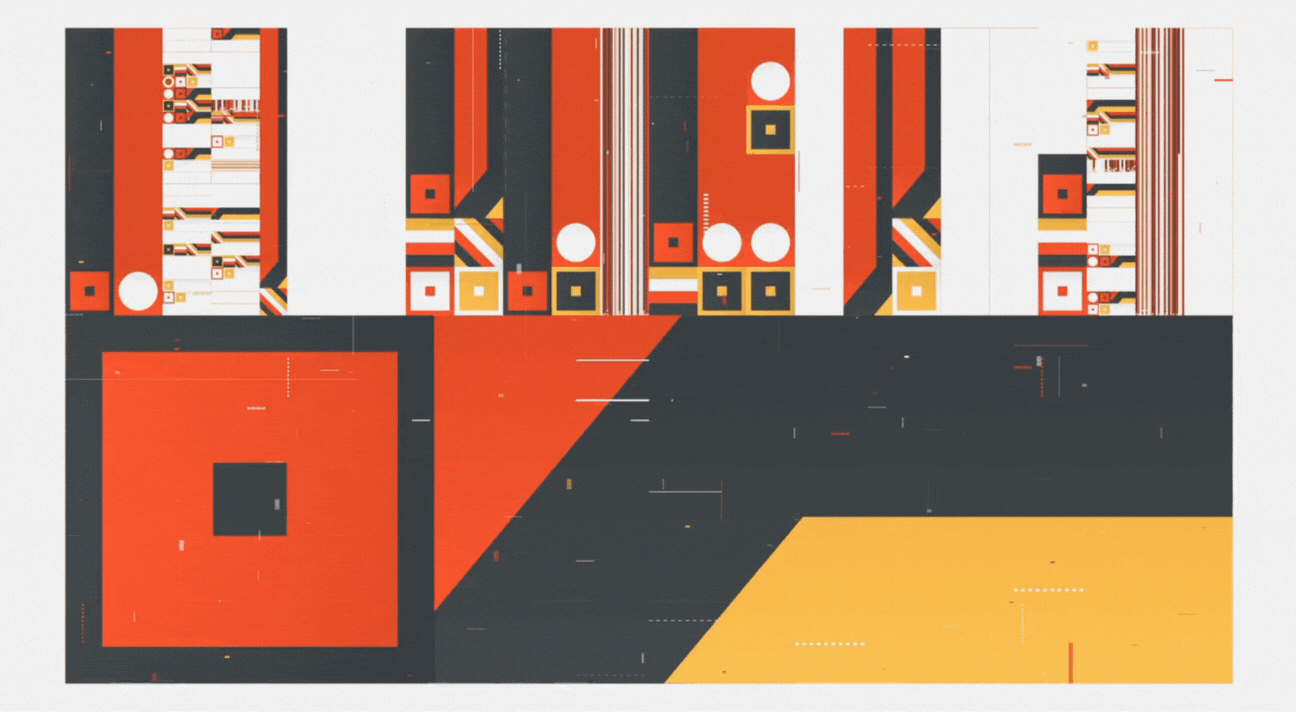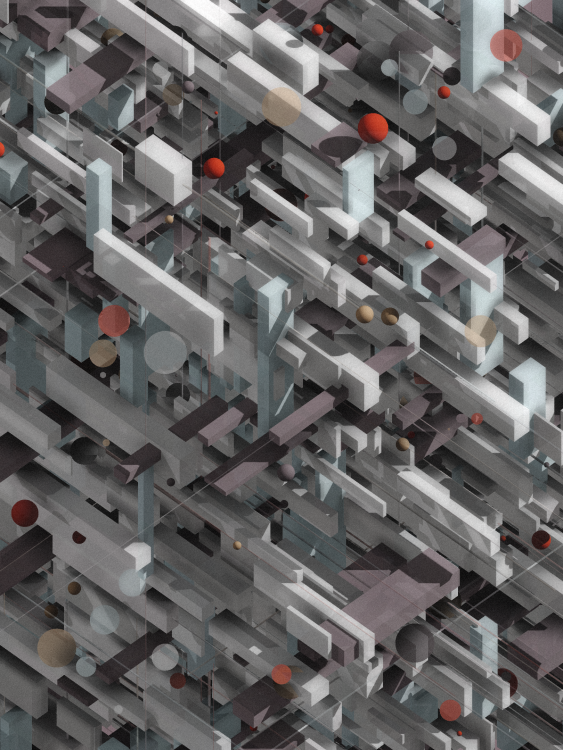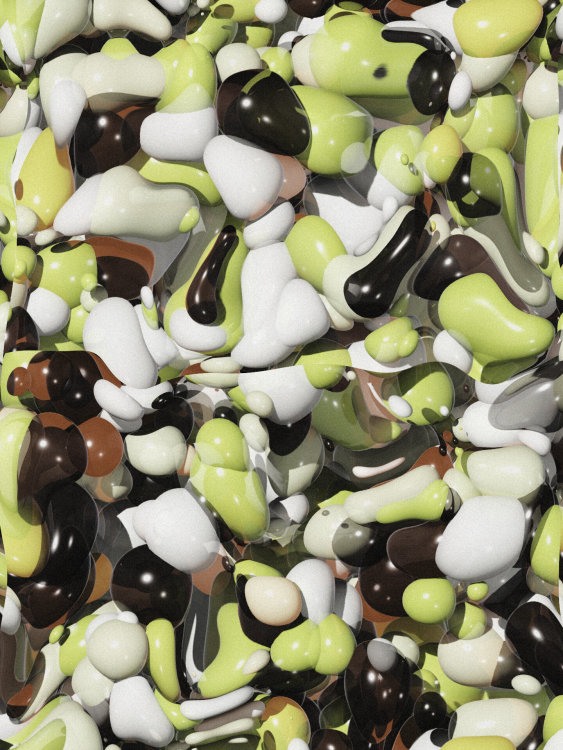Darien Brito, Quadrature, 2023
Where Code & Algorithms Meet Shape & Form: Interview with Darien Brito
Verisart presents a conversation with artist Darien Brito about his work featured at GEN/GEN: Generative Generations, an exhibition we co-curated with Gazelli Art House. We delve into his practice and perspective on the dynamic world of generative art.
Audio-visual artist and creative coder Darien Brito specializes in computer graphics, sound, and generative art. With a foundation in various coding languages, Brito uses algorithms to create his artworks.

In his recent work, Laterals, showcased at our September exhibition with Gazelli Art House, Brito utilized fundamental primitives of 3D computer graphics. The artwork, emerging from an organized structure amidst noise, conveys intentional design, despite the random nature of the algorithms used.
Brito is currently extending his generative art practice to live performances and immersive installations that integrate electronics with real-time visuals and dynamic lighting.
Natalia Chow, Community Lead at Verisart, discussed these themes with Brito, exploring his inspirations and approach to art and the way artists and audiences connect in the digital art community.

Natalia: With Laterals in focus, how have your inspirations shaped your creative approach?
Darien: Laterals evolved as an extension of the techniques I initially employed in another project called Vahria. In Vahria, my primary focus was on crafting distorted objects, but when it came to ‘Laterals,’ my aim was to explore more solid and tangible forms. For that purpose, I used shapes like boxes, spheres, and lines. A central concept I toyed with was the idea that as human beings, we possess a natural tendency to seek patterns and order even within seemingly random arrangements.
Throughout my creative journey, I have always been drawn to creating animated outputs. However, for Laterals I decided to make static pieces.
Natalia: You've previously discussed the relationship between music, soundscape, and visual art. Could you elaborate on how you've integrated these elements into your generative art?
Darien: To claim that my visual art is directly shaped by music would be misleading. Instead, the connection between my music and art is more pragmatic. My experience working with computers and algorithms had a significant impact on how I approached music when I was a composer and performer. My journey into visual art almost naturally followed as a consequence of this influence, as I began crafting graphics primarily for debugging the algorithms I was developing for composition.
For instance, while creating software for an oscillator based on a chaotic signal like the logistic map, I had to plot the signal over time to check if it was correct; otherwise it was simply impossible to know. It was the intriguing visual results of these endeavors that captivated me. Consequently, I started developing algorithms with the sole purpose of generating visuals. In my case, this relationship boils down to a systematic approach to the creative process. I typically begin with an idea for a system and allow the art to emerge from there, whether it takes the form of sound or visuals.

Natalia: You've commented that people tend to seek order in chaos. Can you discuss the emotional or experiential impact you aim to achieve with your artwork? Is this something you hope viewers will take away?
Darien: In general, I don't aim to convey any specific emotion or experience through my artwork. I've never been a fan of lengthy, dramatic or conceptual explanations for my pieces because I believe they can detract from the art itself. While it can be interesting to learn about the processes and motivations that led an artist to a certain place, I prefer audiences to personally extract meaning and explore my work without much guidance. I believe that the enjoyment and power of art are ineffable and intimate, and I want viewers to have their own unique experiences with my pieces.
Natalia: How do you strike a balance between traditional art forms and digital mediums in your creations?
Darien: I haven't really pondered that aspect much. My career as an artist is deeply rooted in the digital medium, and I've never felt the need to strike a balance between it and other art forms. It's worth noting, though, that just because something is created digitally doesn't mean it's non-traditional.
In terms of content, much of digital art often replicates themes in the "traditional" art canon and emulates its techniques. It even simulates imperfections and scratches on canvas or the texture of paint and paper. These approaches still adhere to the traditional principles of art, even if they're executed using computers and code. Digital art has its own unique mannerisms, clichés, traditions, and canons, much like analog forms of art. The main distinction lies in the relative youth of the digital medium, which hasn't had enough time perhaps to become part of our collective knowledge.

Natalia: How has Art Blocks Engine influenced or guided your artistic choices, especially regarding audio-visual elements?
Darien: Creating generative art on the Art Blocks Engine involves working within tight constraints, emphasizing minimal code length and resource usage. As such, it is more about limitations than opportunities. The engine requires compromises in your code due to challenges related to on-chain data storage and the need for efficient execution on a browser. The programs I develop for non-blockchain projects are markedly different, requiring more computational resources and leading to generally more complex and sophisticated results.
However, I've discovered that these enforced constraints can actually foster imagination and creativity. Artists are pushed to find both technical and aesthetic solutions to work around these limitations. Despite the occasional frustration, I find this problem-solving process highly enjoyable.
Natalia: Lastly, how would you characterize the evolving relationship between artists and audiences in the current digital and generative art landscape?
Darien: If we adopt a broad definition of generative art and digital content, it becomes evident that audiences have been experiencing it for a significant amount of time through various mediums like video games, installations, shows, exhibitions, concerts, movies, and more. Mass adoption of this medium is quite common and thriving, as audiences generally enjoy it.
However, the introduction of NFTs and the digital art economy, which emerged as a result, introduced a different kind of audience that was largely absent before. This newer audience is primarily composed of institutions, including museums, galleries, representatives, and digital art collectors who place a high value on tracking the provenance of digital artworks. This phenomenon is recent and draws on principles from traditional art dealing.
The relationship between digital artists, particularly those working with code, and this more institutional audience is marked by fragmentation and difficulty. This is because neither group is accustomed to nor adequately aware of the values and principles of the other. Furthermore, the sustainability and stability of the economy on which this relationship is based add to the complexity. From the perspective of artists, there is a considerable amount of disillusionment with how some of the fundamental promises of NFT technology turned out to be false, such as the idea of fair royalties. Additionally, over time, platforms that initially presented a radical new approach to art dealing have either closed down or slowly reverted to more conventional ways of thinking about it. I hope that innovation remains and alternative narratives emerge and survive.
For more discussions by leading artists in generative art, check out our blog post and replay the the conversation on ‘What’s New About Generative Art’
See available works by Darien Brito exclusively on the Gazell.io store. For more information, visit the artist’s website and his Instagram.
Laterals was minted via Art Blocks Engine and was made available through the Gazelli storefront, facilitated by the Verisart Shopify app.
Register your interest for Art Blocks Engine on your store →